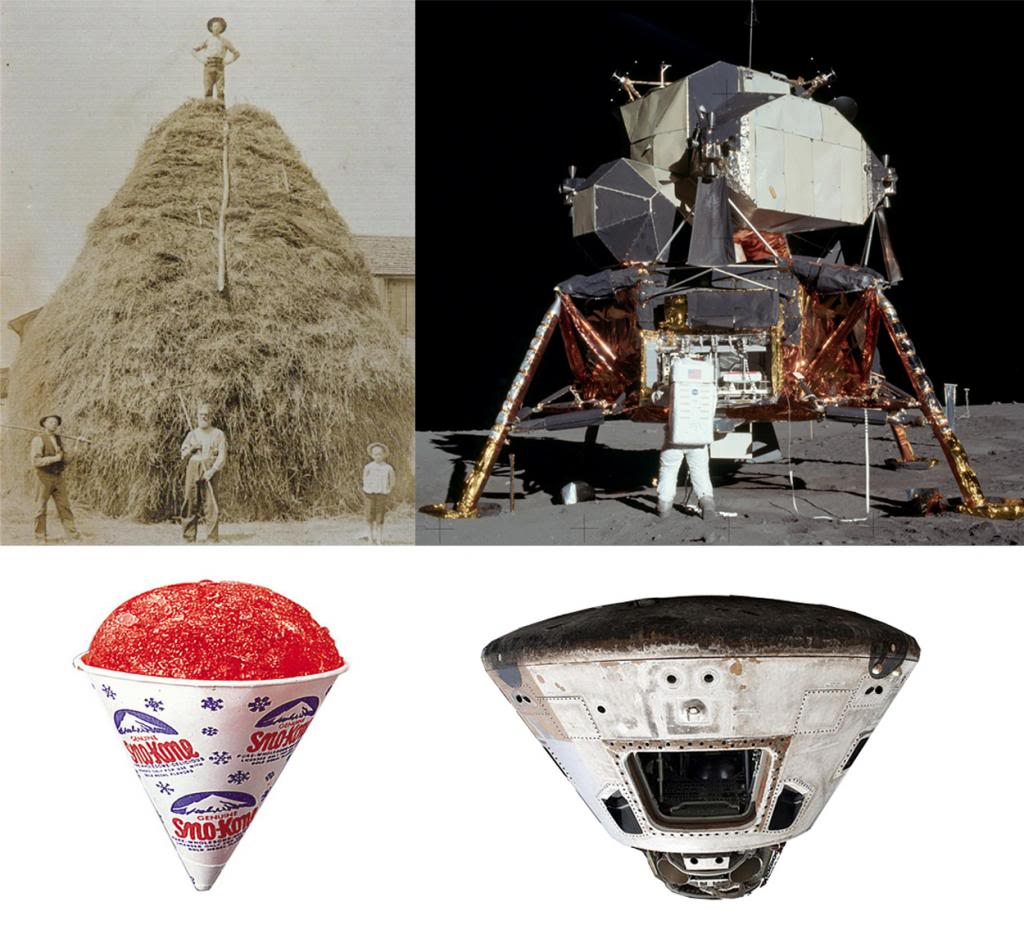|
Author
|
Topic: Apollo 11: Haystack and Snowcone call signs
|
Robert Pearlman
Editor Posts: 43576
From: Houston, TX
Registered: Nov 1999
|
 posted 07-21-2013 02:27 PM
posted 07-21-2013 02:27 PM
   
Recently I was discussing spacecraft names when "Haystack" was mentioned as assigned to an Apollo lunar module. I didn't recall that particular call sign, but sure enough, quoting from NASA's June 25, 1969 Technical Information Summary for Apollo 11 (AS-506)... While separated, the astronauts will use the radio for communication using Code names "Snowcone" for the Command Module and "Haystack" for the Lunar Module. I had always assumed that the eagle on the Apollo 11 patch was influenced by the choice of the crew's call signs, but the emblem was released before the technical summary (by at least several weeks), so was it the other way around? What was the origin of "Haystack" and "Snowcone" as Apollo 11 call signs? Why did they change to "Columbia" and "Eagle"? And did the names appear anywhere else other than the technical summary? |
David Carey
Member Posts: 802
From:
Registered: Mar 2009
|
 posted 07-21-2013 06:27 PM
posted 07-21-2013 06:27 PM
   
Perhaps it was related to shapes of the respective vehicles? |
LM-12
Member Posts: 3324
From: Ontario, Canada
Registered: Oct 2010
|
 posted 07-21-2013 08:15 PM
posted 07-21-2013 08:15 PM
  
quote:
Originally posted by Robert Pearlman:
I had always assumed that the eagle on the Apollo 11 patch was influenced by the choice of the crew's call signs
The Call Signs table in NASA SP-4029 seems (to me) to indicate that the call sign was influenced by the eagle on the insignia. I would say that the "eagle" insignia came before the "eagle" call sign. "Eagle", after the eagle selected for the mission insignia
|
ringo67
Member Posts: 181
From: Seekonk, Mass., USA
Registered: May 2003
|
 posted 07-21-2013 08:42 PM
posted 07-21-2013 08:42 PM
   
So, the radio call could have been "The Haystack has landed"?Personally, I don't think it has the same ring as "The Eagle has landed." |
Robert Pearlman
Editor Posts: 43576
From: Houston, TX
Registered: Nov 1999
|
 posted 07-21-2013 09:00 PM
posted 07-21-2013 09:00 PM
   
quote:
Originally posted by LM-12:
I would say that the "eagle" insignia came before the "eagle" call sign.
Indeed, it did. NASA released a litho with the Apollo 11 emblem on June 1, 1969; the Technical Summary with the "Haystack" notation was released on June 25. So during training, did the crew use the "Haystack" and "Snowcone" call signs? Is there any archival footage or audio of them using it? |
LM-12
Member Posts: 3324
From: Ontario, Canada
Registered: Oct 2010
|
 posted 07-21-2013 09:48 PM
posted 07-21-2013 09:48 PM
  
The "Eagle" and "Columbia" call signs were introduced by the crew during a pre-flight press conference on July 5, 1969. See First Man on page 392. Neil Armstrong hints that other call signs were used in simulations, but he doesn't mention them by name. |
Henry Heatherbank
Member Posts: 250
From: Adelaide, South Australia
Registered: Apr 2005
|
 posted 07-22-2013 06:42 AM
posted 07-22-2013 06:42 AM
  
Or "Houston, the Haystack is on the Prairie." |
dabolton
Member Posts: 419
From: Seneca, IL, US
Registered: Jan 2009
|
 posted 07-22-2013 10:09 AM
posted 07-22-2013 10:09 AM
  
Well it was a like finding a needle-in-a-haystack since Collins couldn't locate it from above. |
Headshot
Member Posts: 891
From: Vancouver, WA, USA
Registered: Feb 2012
|
 posted 07-22-2013 11:24 AM
posted 07-22-2013 11:24 AM
   
Robert, have you discovered any other written NASA documents, beside the Technical Information Summary dated June 25, 1969 that reference Haystack and Snowcone?I am wondering if that Technical Information Summary was written before the actual call signs were chosen. Haystack and Snowcone might have been mere placeholders (albeit, taken from the crew's simulations) over which the real call signs would have been typed. Someone may have forgotten to correct the TIS and it was released on June 25th with the placeholder names. Just a possibility. |
Blackarrow
Member Posts: 3160
From: Belfast, United Kingdom
Registered: Feb 2002
|
 posted 07-22-2013 03:09 PM
posted 07-22-2013 03:09 PM
  
"Haystack" and "Snowcone"? It makes "Spider", "Gumdrop", "Snoopy" and "Charlie Brown" seem positively highbrow... |
David Carey
Member Posts: 802
From:
Registered: Mar 2009
|
 posted 07-22-2013 03:57 PM
posted 07-22-2013 03:57 PM
   
A more obscure possibility for 'Haystack' - a nod to MIT's Haystack Observatory. Operations began in 1964, and for the first ten years the primary role of Haystack was as a planetary astronomy radar, observing the reflection characteristics and orbital parameters of the Moon, Venus, Mars, and Mercury. Topographical characteristics of the lunar surface were examined with emphasis on the proposed landing sites for the Apollo lander, and similar observations were made in support of the Viking lander on Mars. |
YankeeClipper
Member Posts: 622
From: Dublin, Ireland
Registered: Mar 2011
|
 posted 07-23-2013 10:26 AM
posted 07-23-2013 10:26 AM
   
The MIT Haystack reference is possible, as Aldrin got his DSc in Astronautics from MIT in 1963.The callsign "Haystack" could also possibly have originated from Haystack Butte at Edwards AFB, CA. This is very close to the Air Force Rocket Propulsion Laboratory AFRPL/NASA Test Areas 1-120 and 1-125 which were extensively used in the 1960s for Apollo Saturn V Rocketdyne F-1 engine testing. Armstrong would have been aware of this topographical feature from his days as a test pilot. |
John Charles
Member Posts: 342
From: Houston, Texas, USA
Registered: Jun 2004
|
 posted 01-23-2020 05:49 AM
posted 01-23-2020 05:49 AM
  
I don’t think they meant anything except as distinct, 2-syllable placeholders. Probably on some sort of established list. |












